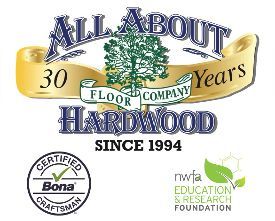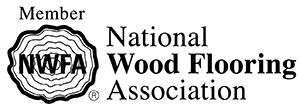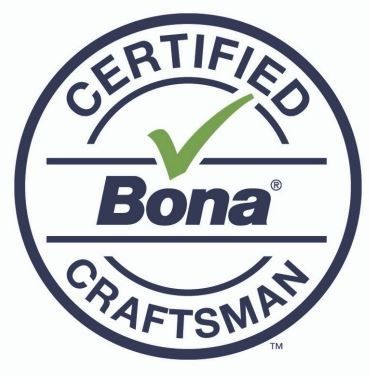FAQs
All About Hardwood Floor Company
Have a flooring-related question? We have the answer at All About Hardwood Floor Company. Check out these FAQs and give us a call today for more information!
What are the differences between laminate, engineered, and solid floors?
Laminate: Laminate flooring features a photographic image of wood on a plastic surface bonded to a compressed board. It’s not real wood and cannot be sanded or refinished. Typically about 1/4 inch thick, laminate planks are installed using a “floating” method - glued to each other and laid over a foam underlayment, not attached directly to the subfloor. Laminate is an affordable alternative, but it lacks the authenticity and longevity of real hardwood.
Engineered: Engineered hardwood consists of a real hardwood veneer layered over multiple plywood substrates. The thickness of the top hardwood layer determines how many times it can be sanded and refinished. While most engineered floors are prefinished, some are available unfinished. Depending on the product, some engineered floors can be refinished as often as traditional solid hardwood. They offer flexible installation options: floating, gluing, or nailing to the subfloor.
Solid: Solid hardwood is made from a single piece of real wood, typically 3/4 inch thick, though thinner options exist. When properly maintained, it can be sanded and refinished eight to 12 times over its lifespan. Available in both prefinished and unfinished varieties, solid hardwood is installed by nailing or stapling directly to a wood subfloor.
What are the differences between prefinished and unfinished floors?
Prefinished floors: These floors are stained and finished at the factory before installation.
Advantages:
- Faster installation, as there's no need for on-site sanding or finishing
- Cleaner process with minimal dust
- Low odor, since finishing is done off-site
- Can often be completed in just one day, depending on the project size
Disadvantages:
- Most have beveled or micro-beveled edges that can trap dust and debris, making maintenance more difficult
- Limited color options compared to unfinished floors
- Manufacturer warranties are often vague and may not cover gloss reduction
- Factory finishes may not always meet homeowner expectations
Unfinished floors: These are installed raw and then sanded, stained, and finished on-site. They remain the most common choice in homes today and can typically be sanded eight to 10 times over their lifespan.
Advantages:
- Can be sanded and refinished multiple times
- Offers a wide range of stain colors and finishes
- Smooth, bevel-free surface makes cleaning easier
- Easier to repair or extend with matching wood
- Allows for custom touches like medallions, borders, and inlays
- Compatible with high-performance water-based polyurethanes, which can be up to three times stronger than traditional oil-based finishes
Disadvantages:
- Sanding can produce dust unless using a dust containment system like Bona’s
- Requires at least two days to complete the finishing process
- With fast-drying products, floors can be walked on after two to three hours (light traffic only, no shoes)
We offer a wide selection of prefinished flooring from trusted brands like Kahrs, BR111, Mirage, Somerset, Bruce, and Robbins.
I want to sand and refinish my hardwood floors. Once I removed my carpet, I noticed several pet stains or plant/water stains. Can they be sanded out or repaired?
In most cases, deep stains, especially dark ones, penetrate too far into the wood to be removed by sanding alone. The darker the stain, the deeper the damage. The most effective solution is to replace the affected boards. However, matching new wood to an older floor can be challenging, as the color and grain may differ. If the stain is confined to a small area, you might be able to use boards from a less visible spot, like a closet, to achieve a better match. For floors with multiple severe pet stains, full replacement is often the best option.
What will screening my floor accomplish over sanding and refinishing?
Screening, also known as buffing, is a light sanding process that removes minor surface marks from everyday wear and tear. After screening, a fresh coat of finish is applied, typically just one. This process is relatively quick, often completed in a single day. However, screening won’t eliminate deep scratches, dents, or areas where the finish has worn down to the stain. In those cases, a full sanding and refinishing is necessary to restore the floor’s appearance.
What can I do to prepare for the day my floors are going to be sanded?
Preparation depends on the size and scope of the project, but here are a few general steps to follow:
Pets: Keep pets away from the work area, ideally at a friend’s house or in a closed-off part of the home. Freshly coated floors can be easily damaged by paws, and the chemicals used may be harmful if ingested. Loud sanding equipment can also affect your pet’s hearing.
Floor removal: If you're removing carpet or tile yourself, take care not to damage the wood underneath. Knife marks can be permanent, and older tile may contain asbestos, which should only be handled by professionals.
Furniture and dust control: Clear all furniture from the room. If the space connects to other areas, hang plastic sheeting to help contain dust.
Climate control: Keep your HVAC system running, warm in winter, cool in summer, to maintain a stable environment for the finish to cure properly.
How long do I have to wait before I can walk on my new hardwood floors?
For prefinished floors, you can walk on them immediately after installation. For site-finished floors, light foot traffic is usually okay after two to three hours. Wait at least two days before moving furniture back in, and one week before placing area rugs.
How difficult is it to install a special floor pattern, inlay, or medallion?
Adding borders, medallions, or custom patterns isn’t difficult for experienced professionals, but it does require extra planning and time. Be sure to allow for a longer project timeline if you’re including these custom features.
What is the best way to speed up the drying process?
Keep your home’s temperature set to around 70°F and use fans to circulate air away from the newly finished floors. This helps the finish cure more quickly and evenly.
Is the choice of hardwood important?
Absolutely. The right hardwood should match your lifestyle. For example, a soft wood like yellow pine may not hold up well in a busy household with pets and kids. Choosing a durable species ensures your floors stay beautiful for years to come.
What rooms are suitable for hardwood flooring, and which should be avoided?
Hardwood can be installed in nearly every room of the house - except full bathrooms, where high humidity and water exposure can damage the wood. It's a great choice for living rooms, bedrooms, hallways, and even kitchens with proper care.




Share On: